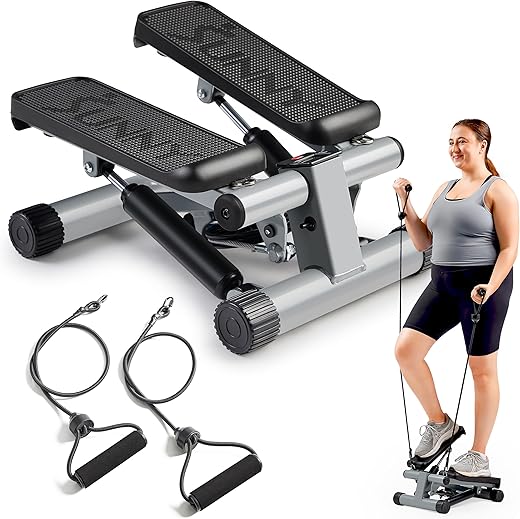This step-by-step guide provides essential insights for selecting the best cardio equipment for your home. It emphasizes the importance of aligning your choice with your fitness goals, available space, and budget. By considering personal preferences and the variety of equipment options, the guide aims to help you create a motivating and effective workout environment that supports your fitness journey.
Choosing the Ideal Cardio Equipment for Your Home Gym
Assess Your Fitness Goals
Identify your primary fitness objectives. Reflect on what you truly want to achieve with your fitness journey. Consider the following options:
- Weight Loss: Focus on activities that burn calories effectively, such as running, cycling, or high-intensity interval training (HIIT).
- Cardiovascular Health: Prioritize exercises that elevate your heart rate, including swimming, brisk walking, or dancing.
- Endurance: Select workouts that build stamina over time, such as long-distance running, cycling, or rowing.
- Training for Specific Events: Choose a program tailored to your event, whether it’s a marathon, triathlon, or obstacle race.
Write down your goals clearly and keep them visible. This will help maintain your motivation and focus as you progress. Regularly reassess your objectives to ensure they align with your evolving fitness level and interests. As you determine these goals, think about how they will influence your choice of equipment. For instance, if your aim is weight loss, invest in a good pair of running shoes or a jump rope. If you want to enhance cardiovascular health, consider purchasing a stationary bike or a set of resistance bands for versatile workouts.
Consider Your Space
Evaluate the available space in your home for cardio equipment by identifying areas that are both spacious and functional. Look for spots like a corner of your living room, a basement area, or even a garage that can accommodate the equipment without hindering daily activities. Consider how much space you can dedicate to your cardio machine; for example, if you’re eyeing a treadmill, make sure there’s room not just for the length of the machine, but also for the space needed around it for safety and movement. Aim for at least two feet of clearance on either side and behind the equipment to ensure that you can get on and off comfortably without risk of injury.
Measure the area where you plan to place the equipment to ensure it fits comfortably. Use a measuring tape to determine the length, width, and height of the intended space. Mark the dimensions on the floor with tape to visualize how the equipment will fit. For instance, if you’re considering a stationary bike, ensure that the marked area allows you to pedal without obstruction. Don’t forget to take into account any nearby obstacles like furniture or doorways that could limit your movement. After measuring, double-check the specifications of the cardio equipment you’re interested in, as this will help you make informed decisions about what can realistically fit in your chosen space.
Set a Budget
Establish a budget for your cardio equipment purchase by researching the price range of various machines. For instance, treadmills can range from $300 to over $3,000, while stationary bikes may cost between $200 and $2,000. Determine what type of machine fits your fitness goals and lifestyle. Allocate funds for maintenance costs as well, which can include regular servicing, replacement parts, and even repairs. Set aside approximately 10% of your budget for unexpected expenses to ensure you’re covered.
Factor in the cost of additional accessories that can enhance your workout experience. This might include a heart rate monitor, workout mats, or specialized shoes designed for cardio workouts. Decide how much you are willing to spend on these extras and include them in your overall budget. For example, if you plan to purchase a treadmill for $1,000, consider budgeting an additional $100 for accessories. Break down your total budget into categories to keep track of your spending and ensure you don’t exceed your financial limits.
Research Equipment Options
Explore various types of cardio equipment, starting with treadmills. Consider the features that matter most to you, such as programmable workouts, incline settings, and built-in heart rate monitors. Read user reviews to understand how each model performs in real-world situations, focusing on durability, noise levels, and ease of use. Pay attention to the size and weight of the treadmill, as well as the space you have available at home. Take note of options that come with connectivity features like Bluetooth or app integration, which can enhance your workout experience.
Investigate ellipticals next, evaluating their low-impact benefits that make them ideal for joint health. Look for adjustable resistance levels and stride length to find a machine that fits your workout style. Check for additional features like heart rate sensors and programmable workouts, which can help keep your sessions varied and engaging. Transition to stationary bikes, noting the differences between upright and recumbent models to determine which aligns with your comfort and fitness goals. Finally, examine rowing machines for a full-body workout, focusing on user feedback regarding ease of assembly and storage. Collect all this information to make an informed decision that aligns with your fitness journey.
Test Before You Buy
Visit a local store to explore the fitness equipment you are considering. Doing this allows you to physically interact with the machines, giving you a better sense of their size, weight, and features. Grab a pair of dumbbells or try out a treadmill. Notice how they feel in your hands, how easily you can adjust settings, and how comfortable the equipment is to use. Pay attention to the cushioning on machines like the elliptical or stationary bike; a comfortable seat can make a significant difference in your workout experience.
Test various machines to see which ones align with your fitness goals. If you’re focused on strength training, try out different weight machines and free weights to find the right grip and resistance for your needs. If cardio is your priority, hop on a treadmill, rower, or stationary bike to gauge their functionality and comfort. Don’t hesitate to ask store staff for assistance; they can offer valuable insights into the features and benefits of each piece of equipment. This hands-on experience will help you make an informed decision before you invest in your fitness journey.
Final Tips for Selection
In conclusion, choosing the right cardio equipment for my home requires careful consideration of my fitness goals, available space, and budget. By thoroughly researching options and testing out equipment before making a purchase, I can ensure that I invest in a piece that not only fits my needs but also motivates me to stay active. With these steps in mind, I’m confident I can enhance my fitness journey and create an enjoyable workout environment at home.
Essential Gear Checklist
Maximize Your Workout
Maximize Your Workout: Essential Tips for Effective Use of Cardio Equipment
- Start with a Warm-Up: Begin each session with a 5-10 minute warm-up to prepare your body and prevent injuries. This could include light stretching or a slow-paced walk on the treadmill
- Learn the Controls: Familiarize yourself with the equipment’s settings, including speed, incline, and resistance levels. Take time to read the instructions or ask a gym staff member if you’re unsure
- Set Realistic Goals: As a beginner, aim for shorter sessions (15-20 minutes) and gradually increase your duration and intensity as you become more comfortable and confident
- Focus on Form: Maintain proper posture while using the equipment. For treadmills, keep your shoulders back, and for stationary bikes, ensure your knees align with your toes as you pedal
- Cool Down and Stretch: After your workout, spend 5-10 minutes cooling down by slowing your pace and then stretching to enhance flexibility and aid recovery
Common Questions About Cardio Machines
When looking for a high-quality rowing machine, there are several key features to consider:
- Resistance Type: Rowing machines typically use air, water, magnetic, or hydraulic resistance. Each type offers a different feel and level of challenge. Air and water resistance provide a more natural rowing experience, while magnetic and hydraulic systems can offer quieter operation and adjustable resistance.
- Build Quality: A sturdy frame made from durable materials, such as steel or high-grade aluminum, is essential for stability during intense workouts. Look for machines with a solid construction that can support your weight and withstand regular use.
- Comfort: An ergonomic seat and handlebar are crucial for comfort during longer workouts. The seat should be well-padded and glide smoothly on the rail. The footrests should also be adjustable and secure to accommodate different shoe sizes.
- Monitor Display: A good rowing machine should have an easy-to-read monitor that tracks essential metrics such as time, distance, strokes per minute, calories burned, and heart rate. Some advanced models may also offer Bluetooth connectivity and compatibility with fitness apps.
- Storage and Size: Consider the machine’s footprint, especially if you have limited space. Some rowing machines are foldable or come with wheels for easy storage, making them more convenient for home use.
- Noise Level: If you live in an apartment or prefer a quieter workout, look for models that operate quietly, particularly those with magnetic or hydraulic resistance.
- Warranty and Support: A good warranty indicates the manufacturer’s confidence in their product. Look for at least a few years of coverage on parts and frame. Customer support is also important in case you encounter issues.
- Price: While high-quality rowing machines can be an investment, it’s important to find one that fits your budget while still meeting your needs. Assess the features that are most important to you and compare options within your price range.
By considering these features, I believe I can find a rowing machine that suits my fitness goals and provides a satisfying workout experience.







When I was considering my space, I realized that my living room was way too small for a treadmill. Instead, I opted for a compact rowing machine, the Concept2 Model D. It fits perfectly under my coffee table when I’m not using it! So, definitely think about how much space you really have before buying.
Great point! Compact options can be a lifesaver in tight spaces. Rowers are often overlooked, but they provide a great full-body workout. Thanks for sharing your experience!
A tip I’d add is to watch for sales! I was able to snag a NordicTrack treadmill during a holiday sale which saved me a ton of cash. Also, don’t forget about the warranty and customer service reputation—those things matter when you’re investing in equipment!
Absolutely! Sales can make a huge difference in the final price. Plus, a good warranty can give you peace of mind, especially with bigger purchases. Thanks for the heads-up!
I totally agree with the importance of assessing your fitness goals first! For me, I wanted to build endurance and lose weight, so I went with a Peloton bike. It’s helped me stay motivated with all the classes and community vibes! Definitely makes a difference when you have clear goals in mind.
I had a slight disagreement with the ‘test before you buy’ part. It’s so tough to find places that have the exact model you want. I ended up reading a ton of reviews online and checking out YouTube videos for the Bowflex Max Trainer. It turned out to be a great buy, but I think having a wider selection to try out would be helpful!
Just wanted to share my success story! I started using an elliptical machine at home (the Sole E35) and within just a few months, I lost 20 pounds and can run 5k without stopping now! Having the equipment at home made it so much easier to stick to my routine. Thanks for this guide—it helped me make the right choice!
Wow, that’s incredible! Congrats on your weight loss and running achievement! It’s amazing how home equipment can transform our routines. Thanks for sharing your journey; it’s truly inspiring!